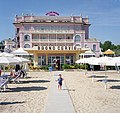Cervia
Cervia | |
|---|---|
| Comune di Cervia | |
 Town Hall | |
show Location of Cervia | |
 Cervia Location of Cervia in Italy | |
| Coordinates: 44°15′31″N 12°21′21″E / 44.25861°N 12.35583°ECoordinates: 44°15′31″N 12°21′21″E / 44.25861°N 12.35583°E | |
| Country | Italy |
| Region | Emilia-Romagna |
| Province | Province of Ravenna (RA) |
| Frazioni | Cannuzzo, Castiglione di Cervia, , Montaletto, Pinarella, Pisignano, Savio di Cervia, Tagliata, Terme, Villa Inferno |
| Government | |
| • Mayor | Massimo Medri |
| Area | |
| • Total | 82 km2 (32 sq mi) |
| Elevation | 3 m (10 ft) |
| Population (16 April 2018)[3] | |
| • Total | 28,700 |
| • Density | 350/km2 (910/sq mi) |
| Demonym(s) | Cervesi |
| Time zone | UTC+1 (CET) |
| • Summer (DST) | UTC+2 (CEST) |
| Postal code | 48015, 48016, 48010 |
| Dialing code | 0544 |
| Patron saint | Saint Paternian |
| Saint day | 13 November |
| Website | Official website |
The neutrality of this article is disputed. (March 2019) |
Cervia (Romagnol: Zirvia) is a seaside resort town in the province of Ravenna, located in the northern Italian region of Emilia-Romagna.
Cervia is a major seaside resort in Emilia-Romagna, North Italy. Its population was 28,700 at the 2018 census.
It's heavily influenced by the presence of sports, art, and cuisine. This contributed to Cervia being selected as Italy's first city to host an IRONMAN Triathlon, giving southern Europe access to the world's most elite athletic event, drawing world-class athletes from all over the world and showcasing Cervia's premier status as a global competitive venue.
History[]
Originally called Ficocle, it was probably of Greek origin and was located midway between current Cervia and Ravenna. It is known that this original settlement was destroyed in 709 by patrician Theodore for its alliance with Ravenna against the loyal Byzantines.
Later the centre was rebuilt in a more secure position, in the Salina. This medieval city grew until it was provided with three fortified entrances, a Palaces of Priors, seven churches and a castle (Rocca) which, according to the legend, was built by Emperor Frederick Barbarossa. The name also changed from Ficocle to Cervia, probably referring to the Acervi, great amounts of salt left in the local evaporation ponds. After a long series of events, it became part of the Papal States.
As time passed, the salt pond turned into a marsh, and on 9 November 1697, Pope Innocent XII ordered it to be rebuilt in a safer location. The new city had huge silos for the storage of salt, containing up to 13,000 tons.
Cervia is also mentioned in Dante's Divine Comedy (Inferno, Canto XXVII, lines 40–42).
Town information[]
Nowadays Cervia is a seaside resort on the thanks to its 10-kilometre (6 mi) shore characterised by sandy beaches. Unlike its neighbour Cesenatico, the buildings are subject to strict urban regulations, favouring the conservation of the pine forest and green areas between each new construction.
Cervia has a large pine forest, about 260 hectares and includes the areas of Milano Marittima, Cervia, Pinarella and Tagliata. A project with the local authority of ARPA is active for the control of water, at various points between the beach in Milano Marittima and that of Pinarella. The results that are obtained show that the water quality is such that guaranteed the city the blue flag of the Foundation for Environmental Education for the ninth consecutive year (since 1997). The levels of these wastewaters have always been excellent in recent years, except some small survey of 2004 and 2002 that triggered the alarm and were provided other controls, which have verified the quality of the water, immediately returned to levels within the normal range.
Housing prices in Cervia ranked second highest in the Emilia Romagna in a 2009 research, only after Bologna. With the development of the neighbourhood Milano Marittima, the presence of nightclubs and outdoor dances were banished from Cervia centre, in order to respect the comfort of residents and tourists.
In Cervia, they are already operating several cycling routes. In fact, the city is also famous for its large number of bicycles around the town, especially during summer.
Tortelli verdi is a typical food in Cervia.
Main sights[]
- The Cathedral (Santa Maria Assunta), built in 1699–1702
- The Museum of Salt
- The Communal Palace
- St. Michael Tower
Transportation[]
The city is served by the road Strada statale 16 Adriatica or Romea South. It is possible reach the Italian A14 highway at Cesena (15 km) and Rimini (24 km). Cervia is located about 103 km south of Bologna, 311 km far from Milan and 359 km from Rome.
Twin towns/sister cities[]
 Southampton, New York, United States
Southampton, New York, United States Monterey, United States
Monterey, United States Jelenia Góra, Poland
Jelenia Góra, Poland Mahón, Spain
Mahón, Spain Cluj-Napoca, Romania
Cluj-Napoca, Romania Aalen, (Germany)
Aalen, (Germany)
Gallery[]

Cervia Harbour in 2015
Harbour

The Beach
City Hall
Beach of Cervia
See also[]
- Diocese of Cervia
Notes and references[]
- ^ "Superficie di Comuni Province e Regioni italiane al 9 ottobre 2011". Istat. Retrieved 16 March 2019.
- ^ "Popolazione Residente al 1° Gennaio 2018". Istat. Retrieved 16 March 2019.
- ^ Dati statistici sulla popolazione Archived 16 April 2008 at the Wayback Machine
External links[]
| Wikimedia Commons has media related to Cervia. |
| Wikivoyage has a travel guide for Cervia. |
- Cities and towns in Emilia-Romagna
- Municipalities of the Province of Ravenna









